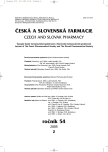Pharmaceutical Hydrophilic Gels
Authors:
Z. Chalupová; R. Masteiková; A. Savickas 1
Authors‘ workplace:
Veterinární a farmaceutická fakulta Brno, Farmaceutická fakulta, Ústav technologie léků
; Farmaceutická fakulta Kaunasské univerzity medicíny, Kaunas, Litva, Katedra technologie léků a OEF
1
Published in:
Čes. slov. Farm., 2005; 54, 55-59
Category:
Review Articles
Overview
From the pharmacopoeial standpoint, gels, together with ointments, creams, pastes, cataplasmata, and medicated plasters, rank among the group of topical semisolid preparations applied to the skin. They are bicoherent systems composed of the internal phase made of a polymer producing a coherent three-dimensional net-like structure, which fixes the liquid vehicle as the external phase. Intermolecular forces bind the molecules of the solvent to a polymeric net, thus decreasing the mobility of these molecules and producing a structured system with increased viscosity. The physical and chemical bonds binding the particles of the internal phase provide a relatively stable structure, which can originate by swelling of solid polymers, or by decreasing the solubility of the polymer in a solution. An important group of gels used in pharmacy are hydrophylic gels, or hydrogels, usually made of hydrophyilc polymers, which under certain conditions and polymer concentration, jellify. Attention of pharmaceutical research now concentrates primarily on hydrophilic gels, as this dosage form seems to be prospective for the development of modern drugs based on systems with prolonged and controlled release of active ingredients.
Key words:
hydrogels – net-like structures – drug transport systems – controlled release
Labels
Pharmacy Clinical pharmacologyArticle was published in
Czech and Slovak Pharmacy

2005 Issue 2
Most read in this issue
- Pharmaceutical Hydrophilic Gels
- Use of Capillary Isotachophoresis for the Determination o Pheniramine in Granulated Powders
- Dispensing Care at the Dispensing Counter in the Conditions of a Czech Pharmacy
- Arbutin, Salicin: The Possibilities of Their Biotechnological Production
